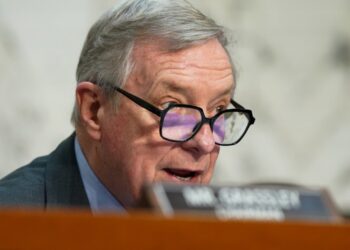
The Cook Political Report on Monday shifted the Pennsylvania Senate race into the “toss-up” category and moved the Nebraska Senate contest from likely to “lean Republican” with just 15 days until the November election.
With Pennsylvania shifting to the right from “lean Democrat,” all three of the “blue wall” states are now toss-ups.
Sen. Bob Casey (D-Pa.) is looking to nab a fourth term in office over Republican David McCormick, who has narrowed the gap to inside the margin of error.
According to Cook, McCormick’s closing of the gap and Casey’s latest ad showing that he sides with former President Trump on trade and tariffs are two of the main reasons behind the shift.
“While public polling in the Keystone State still shows Democratic Sen. Bob Casey with a slight lead, both Republican and Democratic internal polls show this is now a margin-of-error race, with Casey holding a slim, statistically insignificant lead of between one and two points,” the Cook Political Report’s Jessica Taylor wrote.
“Though many of the fundamentals may still very slightly favor Casey, this race is now close enough that it belongs more in the Toss Up column than in Lean Democrat alongside Arizona and Nevada, which have clearly become tougher lifts for the GOP,” she said.
While many on each side of the aisle expected a close result in Pennsylvania, few have expected anything close in Nebraska, where Sen. Deb Fischer (R) has suddenly found herself in a tough fight with independent Dan Osborn, a union leader.
Cook shifted that race from “likely” to “lean Republican.” The only other GOP-held seat in that category is Sen. Ted Cruz’s (R-Texas).
The Nebraska ratings change specifically came hours after the Senate Leadership Fund, a GOP super PAC run by allies of Senate Minority Leader Mitch McConnell (R-Ky.) announced they were boosting Fischer to the tune of $3 million — an unexpected infusion in the ruby red state.
“Overall, this race continues to be too close for Republicans’ comfort,” Taylor wrote. “While publicly Democrats deny they have a rooting interest here — and Osborn has maintained he wouldn’t caucus with either party if he’s elected — an upset win by Osborn could factor in to mitigate a loss for Democrats in Montana.
“Ultimately, we still think the heavy red hue of the state wins out, GOP attacks on Democratic efforts to covertly boost Osborn break through and that Fischer makes it across the finish line,” she continued. “When we’re evaluating where the GOP is on defense, this race is more in line with Texas than it is with Florida. As such, we are shifting our rating from Likely to Lean Republican.”
Fischer is also set to get major boosts at the top of the ticket. Former President Trump carried the state over President Biden by 19 percentage points in 2020, and Sen. Pete Ricketts (R-Neb.), a popular former governor, is also on the ticket for a special election to fill the final two years of former Sen. Ben Sasse’s (R-Neb.) term.
Republicans remain in pole position to win back the majority in November as they only need to flip one more seat, in addition to the one occupied by retiring Sen. Joe Manchin (I-W.Va.).
Their best hope is in Montana where Republican Tim Sheehy holds a polling advantage over Sen. Jon Tester (D-Mont.). Republican hopes have also been on the rise in Ohio where they hope Sen. Sherrod Brown’s (D-Ohio) long-held lead will be overcome by Bernie Moreno.
Cook also moved Wisconsin into the “toss-up” category earlier in the month, joining Ohio and Michigan.






